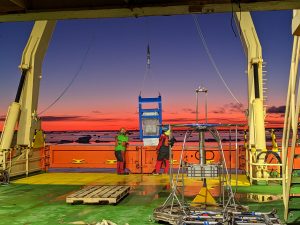
A team of 30 scientists, including a group from The University of Alabama, have returned to the waters surrounding Antarctica to better understand the biodiversity of an understudied group of marine invertebrates and how these animals are affected by climate change.
The spring 2023 Icy Inverts expedition marks the second time in three years that researchers from UA, the University of North Carolina Wilmington, Central Michigan University, the University of Georgia and the University of Alaska Anchorage have ventured to the southernmost continent to study marine life. The first cruise in 2020 took them to the Antarctic Peninsula region while this one focuses on the eastern Antarctic area.
Since 2019, the National Science Foundation, through its Division of Environmental Biology and Office of Polar Programs, has granted more than $4.2 million in intended awards for the researchers to sample and study marine invertebrates and microbes living in some of the most remote seas on Earth.
UA’s portion of the funding comes from a $1.2 million NSF CAREER award to find new species of aplacophorans, a group of poorly known worm-like mollusks with scales or spines, and use advanced imaging and DNA sequencing techniques to classify them.
“There aren’t a lot of people who really know how to identify them, and whenever they go somewhere and apply their expertise, they find new species, new records of other species and sometimes whole new groups,” said Dr. Kevin M. Kocot, UA associate professor of biological sciences and curator of invertebrate zoology for the Alabama Museum of Natural History.
Kocot said Antarctica is a key location for their research because they see how it’s being affected by climate change with how quickly ice there is melting. One of the ways they are monitoring the impact on these animals is by collecting sediment samples with an epibenthic sledge. Since aplacophorans are so tiny, a large sample size can usually be found within a single sample.
Learning how the animals are being affected is the first part of the twofold goal for this project. The second focuses on training the next generation of students to be able to identify them. Joining Kocot on this expedition are five UA students.
“Biology keeps expanding,” said Kocot. “We have a gap in the training of people who are traditional taxonomists, who can identify groups of animals and especially these obscure ones where there might be a handful of experts in the world.”
Approximately 400 species of aplacophorans have been named, but it is estimated that ten times more are waiting to be discovered. While aboard the R/V Nathaniel B. Palmer, Kocot and his students gather the specimens, image them and preserve them. After the team arrives home in May, the samples will be shipped to the Alabama Museum of Natural History on UA’s campus where they will be made available to other researchers around the world. From their 2020 expedition, they were able to bring back roughly 1,500 samples.
“My hope is that people will be able to take advantage of that,” Kocot said. “We just put our collection online in the last couple of years and it’s really increased interest.”
Kocot anticipates a public exhibit at the museum could be ready later in the year. The research team will make a third expedition to Argentinian waters to search for more species in the fall.





Follow the researchers during their travels at Icy Inverts.